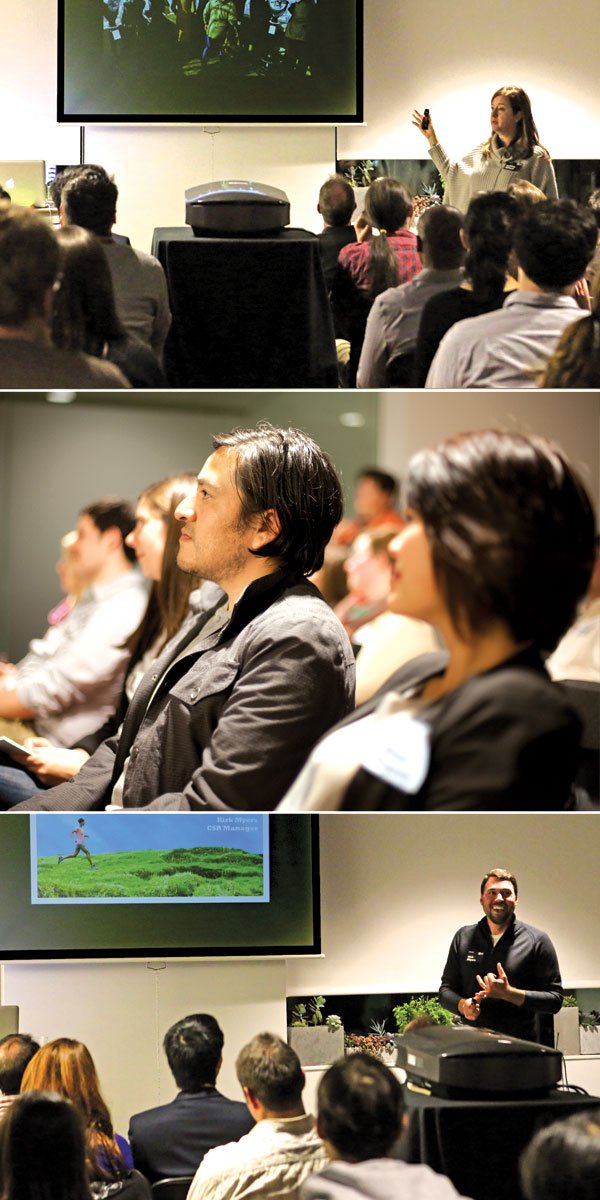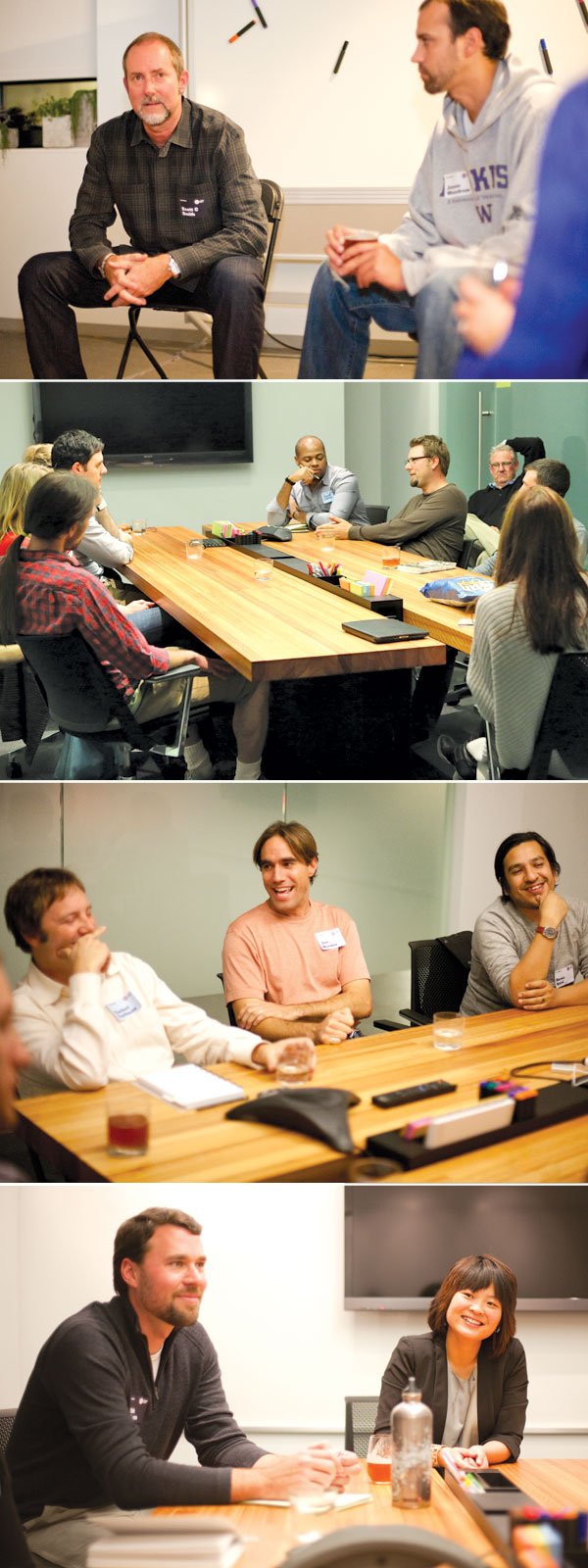Seattle Designers Accord Town Hall Recap
The second Seattle Designers Accord Town Hall was held October 11th at Carbon Design Group’s studio. The event was organized by Carbon, Modern Species and AIGA Seattle. The theme of the night was “Are We There Yet?,” reflecting the seemingly endless journey of designers striving to produce sustainable results for willing clients. Linda Wagner of Carbon and Gage Mitchell of both Modern Species and AIGA Seattle shared the emcee duties. Four speakers delivered short presentations to address the topic from their perspective (industrial design, graphic design, architecture, or business), before continuing the conversation in breakout sessions.
Ashley Arhart
Creative Director of Consumer Experience at Hornall Anderson
Ashley gets props for bringing, well, props. Her message for the evening was that sustainable design is only successful if the consumer likes it. Case in point was the incredibly noisy Sun Chips bag. Compostable, yes, but hearing it in person drove home the problem — nobody wants to broadcast that they’re snacking. Ashley went on to ruffle every print designer in attendance by declaring the book is dead... as an object of information, but alive as an object of desire. To bring this home, she used the example of Wantful, a company that allows you to create a beautiful personalized book filled with a curated selection of gifts from which a recipient can pick. By blending digital and print, Wantful delivers a richer, more meaningful experience. And meaningful experiences are vital because, the success of a product is determined by how it connects with people. (Ashley also wrote up a great detailed post about her breakout session which you can find here.)
Kirk Myers
Corporate Social Responsibility Manager at REI
Kirk’s job is to design business systems that provide sustainable outcomes. One of REI’s greatest successes in this endeavor came from partnering with other outdoor apparel manufacturers like Patagonia and Timberland to create the HIGG Index, which measurers the impact of their products. By working together, these companies were able to give their vendors an assessment tool and a very large incentive to use it. Kirk pointed out that the true focus of any company is whether or not a customer will buy a product. A sustainable design isn’t sustainable at all if no one wants to buy it. Method is a company that gets this in spades. They aren’t successful because they create sustainable products. They’re successful because they create better products with a combination of design, functionality, and affordability that makes them stand out. Sustainable products must be better all around.
George Ostrow
President of VELOCIPEDE architects
Opening his presentation with a graphic that illustrates the serious disconnect between growth and sustainability (hint: growth lines go up and to the right, sustainable lines stay level), George made the observation that growth is simply not sustainable. Even more sobering, was the idea that, despite how everyone talks about “saving the planet,” the world will go on. It was here long before it supported human life, it’ll be here long after. Sustainable solutions are really about saving us. Despite amazing improvements in sustainable building design, Seattle, considered a green city by most, had only 30% of new homes in 2011 achieve a Built Green certification, and just a handful of projects work toward the even more stringent Living Building standard. This deep green standard not only tries to make up for growth by reducing consumption, these buildings also produce their own energy, make do with rainwater that falls on the property, and eliminate waste produced on site. So in answer to the night’s topic, no, we’re nowhere near there yet.
Scott C Smith
Product Strategist, Designer, and Developer
Having worked at major product manufacturers including Microsoft and Targus, Scott gave attendees a window into how hard it can be to integrate sustainability into traditional product design. Challenges came in the form of trying to create measurement platforms that were often only used once, encouraging others working under pressure to meet budgets and schedules to factor in sustainability, and getting customers to understand and associate sustainability with the Microsoft brand. In spite of all these difficulties, Scott stressed the importance of designers continuing to fight for the production of better products because there are successes to be had. He explained that big gains can be made in changes as simple as designing for disassembly, reducing packaging and/or product size, and choosing more sustainable materials.
After the presentations, the speakers led lively breakout sessions. Ashley kicked off hers with a quick game of Genius or Gimmick. (Light bulb packaging that turns into a lamp shade? Gimmick. Pizza food truck made out of a shipping container? Genius!) The discussion that followed brought to light an inherent conflict in sustainable design. We’re all concerned about consumption and using more than we need. This desire to be more sustainable can be in direct conflict with designers’ inherent need to “make.”
George’s breakout proved to be a thoughtful conversation on some of the uniqueness of the region and how green thinking can move into green design within the context of culture, place, and process.
A key takeaway from Kirk’s session was that companies that are already mission-driven are in a much better position to add sustainability to that mission. Product packaging was also discussed as an area where changes can have a positive impact in several areas, from upfront materials costs, to shipping, and final recycling and disposal.
The chat with Scott focused on the challenge of how designers can inspire and influence corporations and clients, to join them in this journey. Being able to understand business aspects, talk across disciplines, and understand what motivates people were all highlighted as valuable skills in these efforts. Ultimately, success can come down to an emotional appeal, convincing others that this is the right thing to do and that we simply need to jump in and start somewhere.
All in all, the night gave designers an opportunity to learn from experts and share the challenges and successes faced by all designers with an interest in sustainability. The Designers Accord Town Hall events continue to fuel and replenish the passion required to keep us all on the path toward more sustainable design.
Written by Jennifer Stewart & Barb Mackintosh
Photos by Calvin Carter, Michael Shriver, Richard Palochak, and Barb Mackintosh




